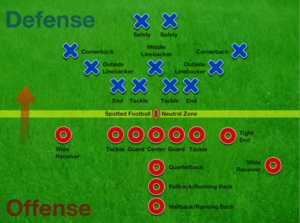American football positions
The width of the spotted football defines the width of the neutral zone, an area of the field no player other than the snapper may position himself in or above before the snap. Each team has its own line of scrimmage, thought of as a vertical plane from sideline to sideline that passes through the point of the ball nearest its own goal line. A formation at the line of scrimmage. Offensive players are marked by O symbols, defensive players by X symbols. This diagram shows two of the most common formations, the offense is in the I formation while the defense is in the 4-3 formation. There are many different formations the players may take. The players on offense must arrange themselves in a formation, all behind their line of scrimmage (that is, on their side of the ball). For reasons of safety and competitive balance, there are strict rules which define the way in which the offensive players may line up. Seven players must line up directly on the line of scrimmage, these are collectively referred to as linemen. Four players line up behind the line of scrimmage, these are collectively referred to as backs. Within this formation, there are six eligible receivers who may receive a forward pass during play. These eligible receivers are the four backs, and the two players at either end of the line. The remaining five linemen, often called interior linemen do not normally handle the ball during a play. Because of these rules, various leagues of American football have enacted strict rules of uniform numbering so officials may more easily judge which players were eligible and which were not at the start of a play. For example, in college football, ineligible players wear numbers 50-79, while eligible receivers wear 1-49 or 80-99. Even wi

hin this structure, offenses can still present a wide number of formations, so long as they maintain the "seven and four" arrangement. Ends, for example, may play close to the other linemen (called tight ends) or they may play some distance down the line of scrimmage, where they are called split ends, or sometimes wide receivers. Of the four backs, they may play behind the linemen, or may play "split out" to provide additional wide receivers. These additional receivers can be flankers (if they play split far wide, but still in the backfield) or slot receivers if they play in the "slot" between the split end and the rest of the offensive line. One of the four backs receives the snap from the center. This player is called the quarterback. The remaining members of the backfield are called a variety of names, depending on their intended role, such as running back, halfback, fullback, H-back, wingback, or slotback. The players on defense may arrange themselves in any manner, as long as all players are "behind the line" (that is, on the side of the line nearest their own end zone). Players who line up opposite the offensive line are called defensive linemen, usually with one or two defensive tackles in the middle (a single defensive tackle is often called the nose guard or nose tackle) and with one defensive end on each side. Behind the linemen are the linebackers. Positioned opposite the wide receivers are the cornerbacks. Farthest back from the line are the safeties, usually in the middle of the field behind the linebackers. The linemen and linebackers, close to the line of scrimmage, are often referred to as playing "in the box", players outside "the box" (usually cornerbacks and safeties) are collectively referred to as the "secondary"